• What are the steps of service
• Step one: Greeting the guest
• Step two: Seating the guest
• Step three: Presenting the menu
• Step four: Taking beverage orders
• Step five: Taking appetizer orders
• Step six: Taking entrée orders
• Step seven: Taking alcohol orders
• Step eight: Running food
• Step nine: Two-bite check and quality control
• Step ten: Pre-bussing and table maintenance
• Step eleven: Offering dessert and after-dinner drinks
• Step twelve: Presenting the check and processing payment
• Step thirteen: Thanking and turning the table
• Choosing the right technology for your restaurant
• Frequently asked questions: Steps of service
The traditional steps of service have shaped restaurant hospitality for centuries, with roots tracing back to late 18th-century France. Following the French Revolution, many out-of-work chefs began opening restaurants and needed new ways to attract and impress guests.
Since then, the core steps of service have largely remained unchanged, proof that the fundamentals of great hospitality can stand the test of time.
What has changed, though, is how restaurants operate and the industry itself.
The challenge is that guest expectations have skyrocketed.
Diners now expect the same speed, accuracy, and personalization they experience from the apps they use on their smartphones every day—standards that can be nearly impossible to deliver with traditional workflow alone.
So what’s the solution?
Technology.
By layering digital tools onto the traditional steps of service, restaurants can meet rising expectations with speed and consistency—while freeing staff to focus on genuine hospitality.
In this article, you will learn:
- What the traditional steps of service are and why they still matter
- How technology is streamlining each step to improve service quality
- What tools to look for to enhance your restaurant operations
Let’s dive into how to modernize your service model without losing the heart of hospitality. But first, let’s look at the basics.
What are the steps of service
Steps of service are a structured sequence of customer interactions that restaurant servers follow to provide guests with an exceptional dining experience—from the warm welcome to payment and the sincere thank you and goodbye.
They act like a checklist for hospitality, making sure no part of the experience gets overlooked.
The details can vary by concept, but traditionally, the sequence includes greeting, seating, presenting the menu, handling beverage service, taking orders, pacing the meal, delivering food, checking in, clearing, and closing the check.
Done well, they help create a consistent rhythm that enhances the guest experience and creates a lasting impression.
For the staff, it provides a roadmap to keep the dining room running smoothly, even during busy periods, so all the guests receive attention without feeling overlooked.
In this guide, we are going to expand on the traditional steps of service to show you new ways technology is giving customers an unforgettable food service journey.
Let’s get into it.
Step one: Greeting the guest

The first impression sets the tone for the entire dining experience.
Guests should immediately be given a warm welcome the moment they walk through the door, and then asked if they have a reservation so they can be seated quickly.
If they don’t have a reservation, and the restaurant is on a wait, staff should communicate clear expectations about how long it will take to be seated and ask guests if they’d like to sign up on the waiting list.
Technology can help make this step smoother and more personalized.
Reservation and waitlist software allows restaurant staff to anticipate arrivals, note special requests like birthdays or dietary restrictions, and greet guests by name.
Diners can sign up for the waitlist at the host stand and receive real-time waitlist data on their phones based on turn times and table statuses.
Staff can text guests when their table is ready, and diners can reply with their own status. This two-way communication makes it easy to answer questions and ensures staff aren’t left in the dark about where guests are or when they’ll arrive.
Step two: Seating the guest
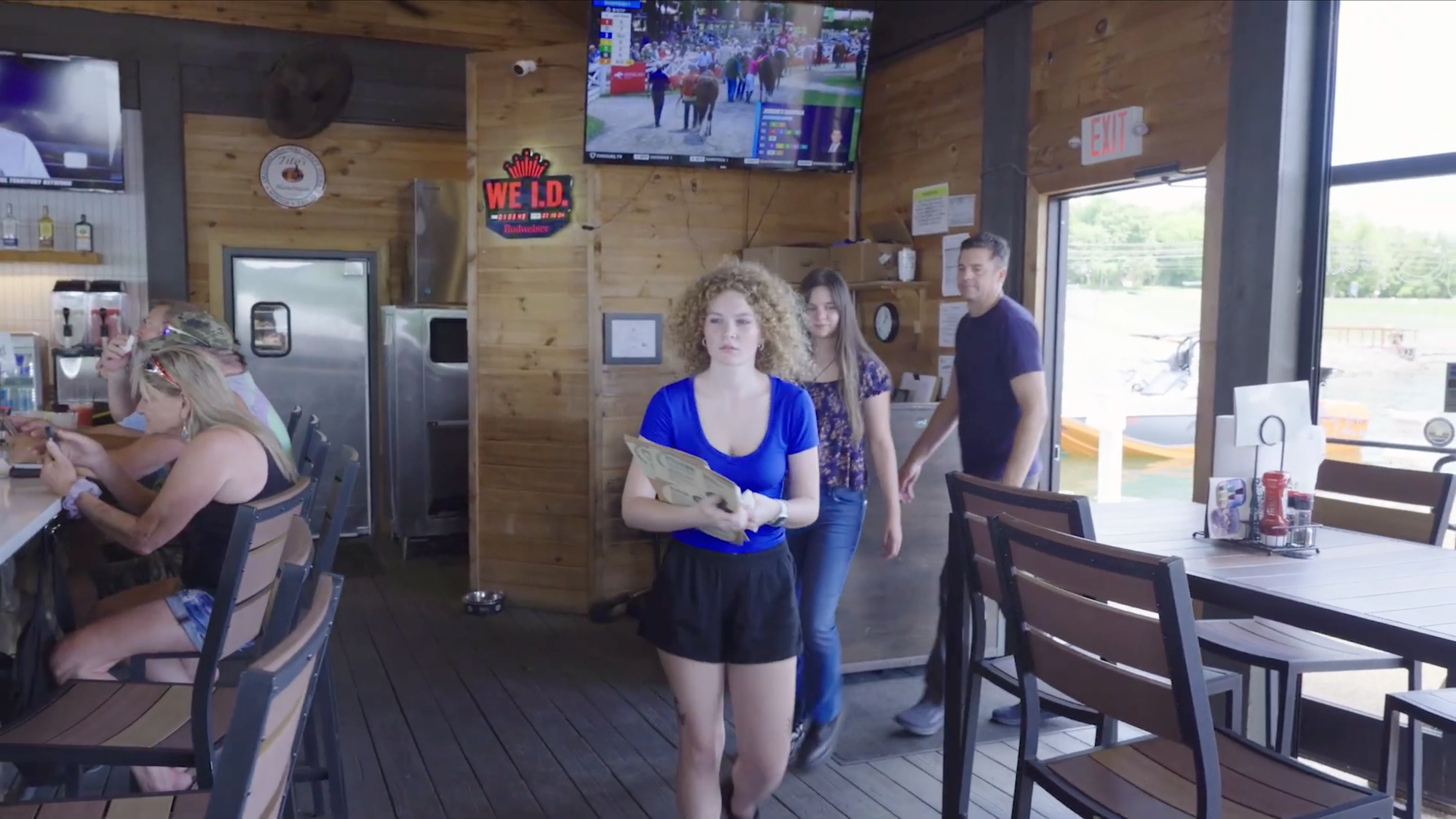
Hosts, managers, or servers will next guide diners to their designated table. Seating guests is relatively straightforward in the steps of service, but it sets the pace and balances server sections to keep the dining room flowing.
When it’s time to seat a party, the reservation system will suggest tables that keep server sections balanced, and the host can then transfer the group from the waitlist to the assigned table in the platform.
With reservation software integrated into the POS system, notes such as birthdays, allergies, or other special requests are automatically passed along, giving servers the context they need before they arrive at the table.
Servers should greet their tables within one minute of being seated, making sure to make eye contact and acknowledge all the guests at the table, and give a genuine, warm welcome.
Step three: Presenting the menu
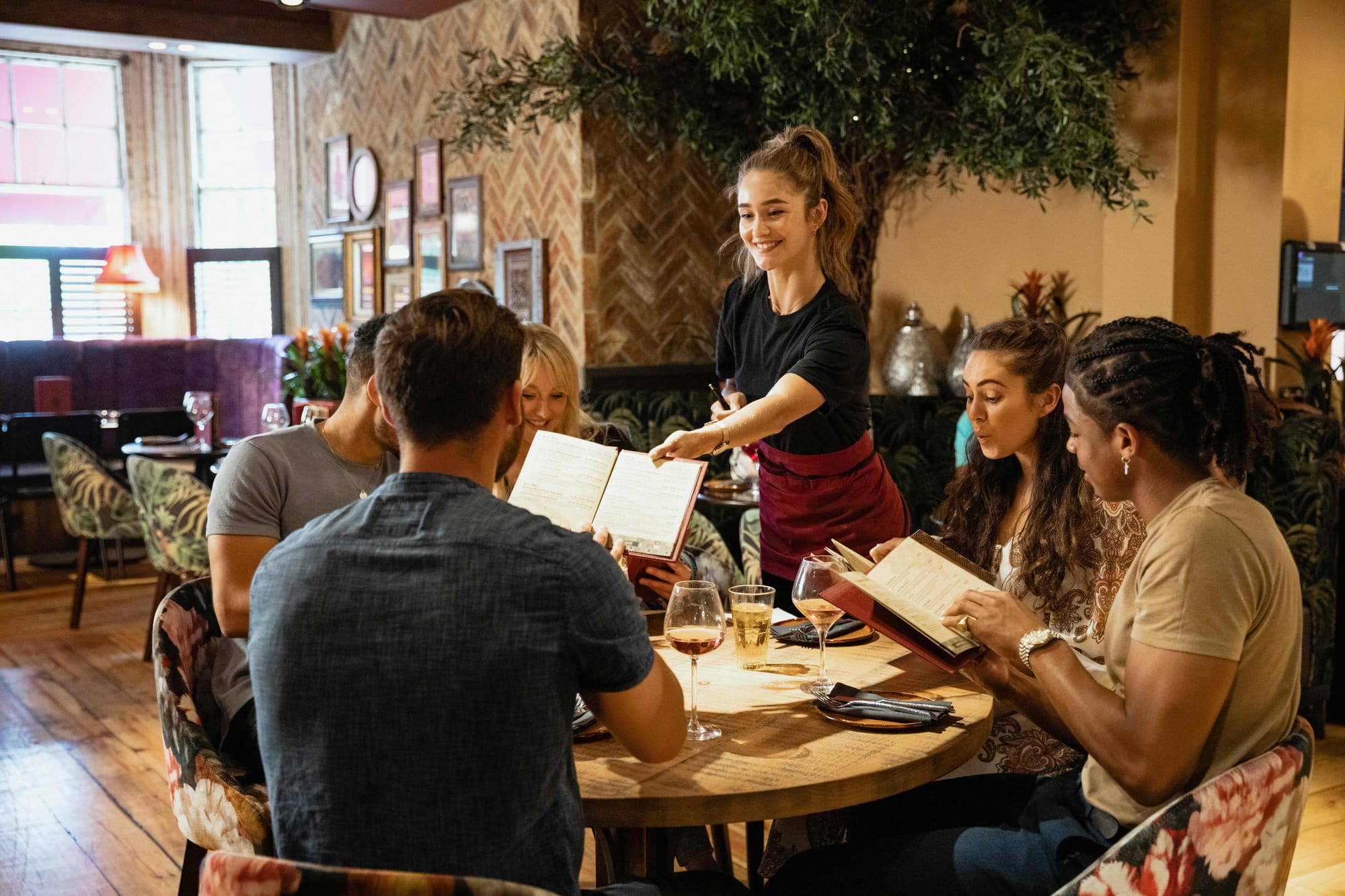
Once guests are seated, servers should give a quick introduction, offer water, and explain how ordering works. This helps set the stage and encourages diners to ask questions as the menu is presented.
Specials or chef recommendations should be explained clearly and confidently. If diners do have questions about the menu that are outside of a server’s understanding, like:
- Can this be made without dairy?
- Does (a specific dish) have soy in it?
- Is there onion in the sauce?
—Servers can give precise answers using their handhelds. Ingredient lists, allergen flags, prep notes, and even images are all stored on the device, so there’s no need to run to the kitchen or find a manager. This boosts service quality and speeds decisions.
Handhelds also pull real-time availability from the POS system—alerting servers when an item is no longer available or showing remaining counts when quantities are limited. Accurate, up-to-the-minute details prevent disappointment, reduce re-fires, and improve the guest experience.
Step four: Taking beverage orders
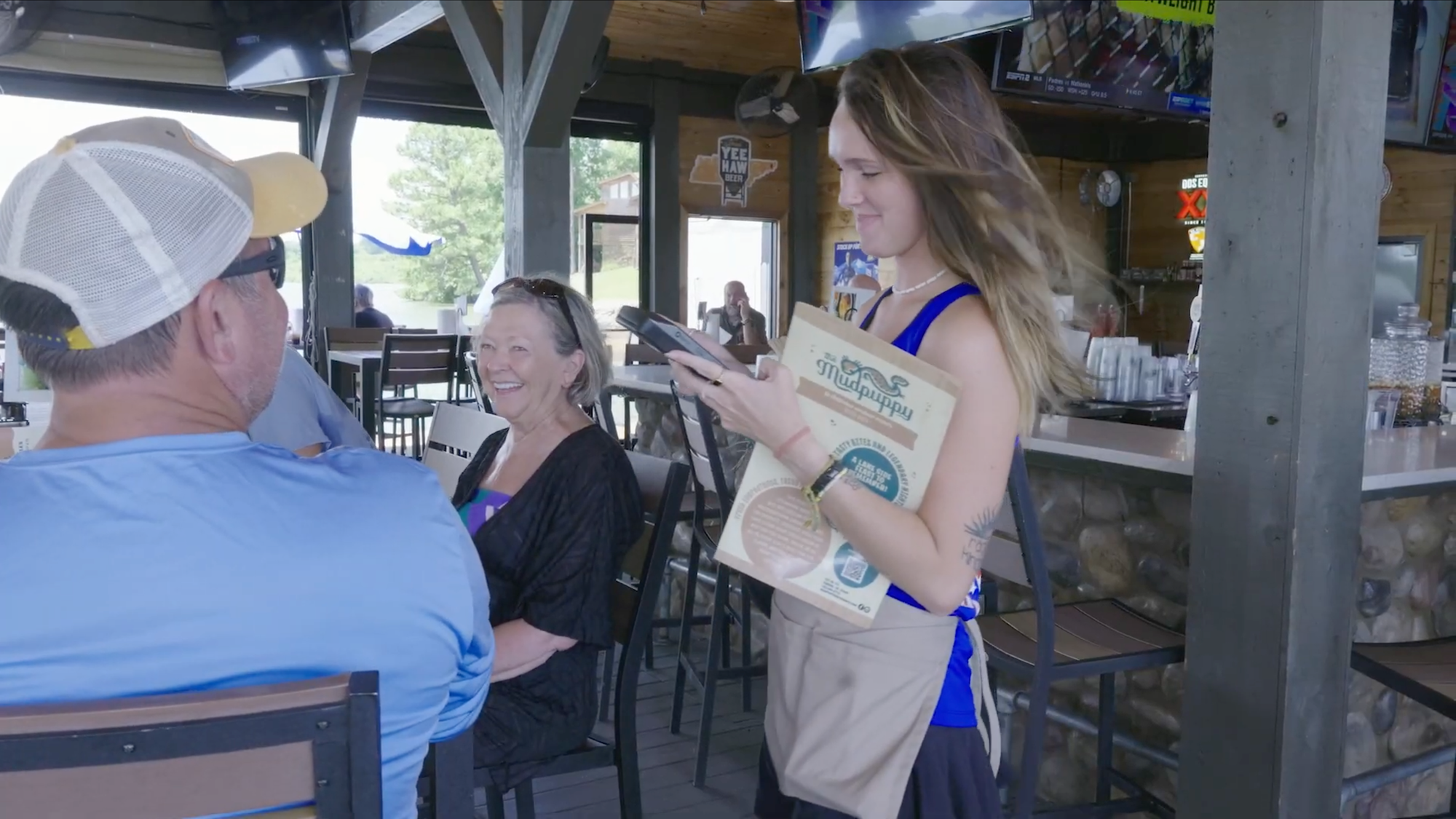
After diners have had a couple of minutes to browse the menu, ask if they have any questions and would they like to have anything to drink—water still/sparkling, non-alcoholic options, or cocktails/beer/wine.
Share drink specials, stand out wines on the wine list, and anything unique that’s going on behind the bar that customers will find interesting.
Use handhelds to fire bar tickets instantly. The moment you enter selections and tap send, the order routes to the bar, eliminating the time it takes for servers to walk to the POS and place the order.
This improves overall service quality and ensures guests receive their drinks without unnecessary waiting—often finishing them sooner, which opens the door for servers to suggest another round or a new option later in the meal.
Step five: Taking appetizer orders
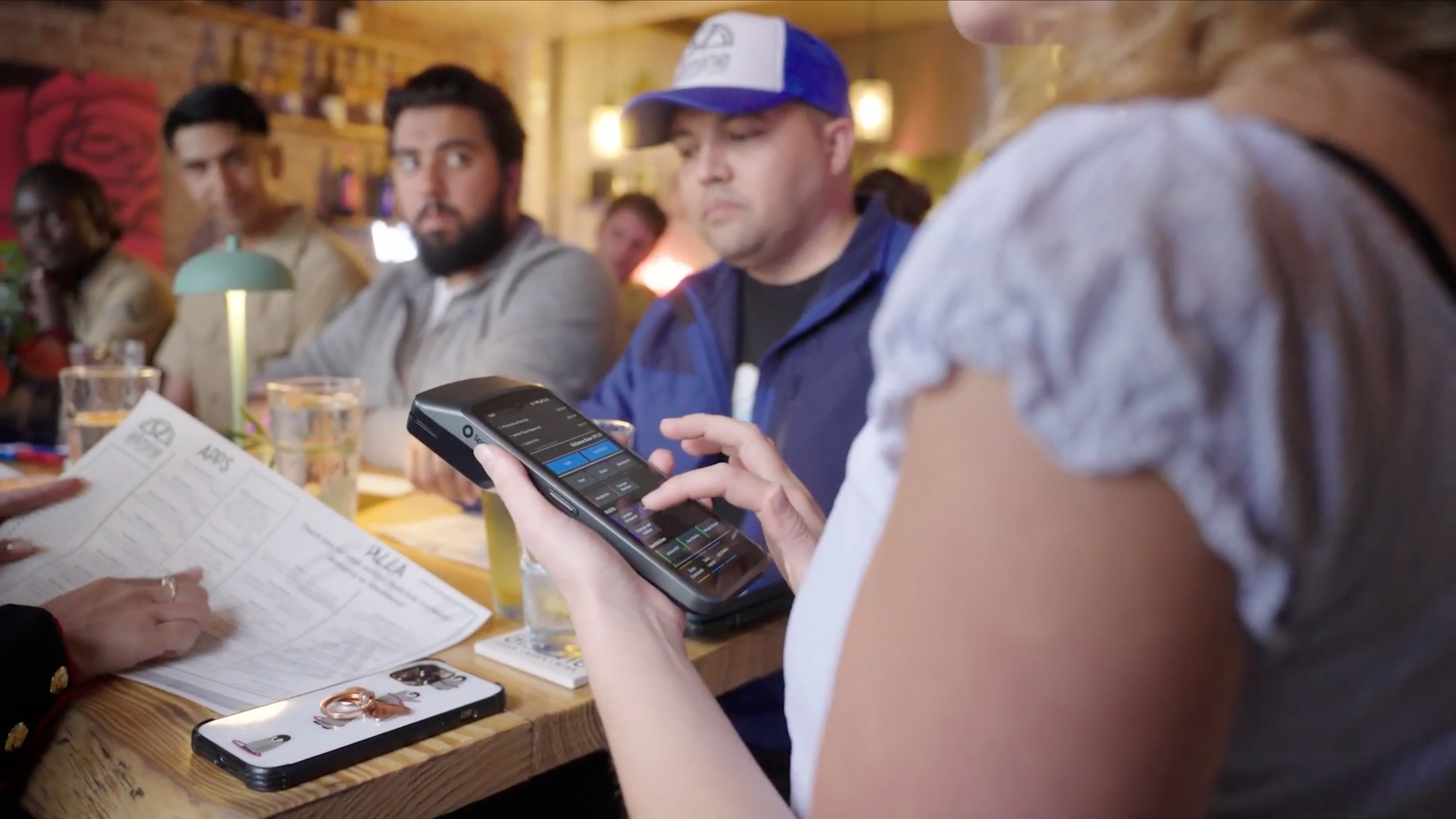
When drinks arrive at the table (3-5 minutes from placing the order), ask diners if they would like to place an appetizer order.
Rather than just asking if they’d like an appetizer, suggest one or two popular menu items that other customers order often.
Using handheld devices to enter orders by seat number ensures that the right dishes are served to the right guests, without the need to awkwardly call out menu items across the table.
Many restaurants train staff to take orders in a consistent pattern, such as clockwise from a starting seat, which keeps service organized and everyone on the same page.
Appetizers should take anywhere from 5 to 15 minutes to arrive at the table, depending on the menu item. But before they do, entrees should already be in the system.
Step six: Taking entrée orders
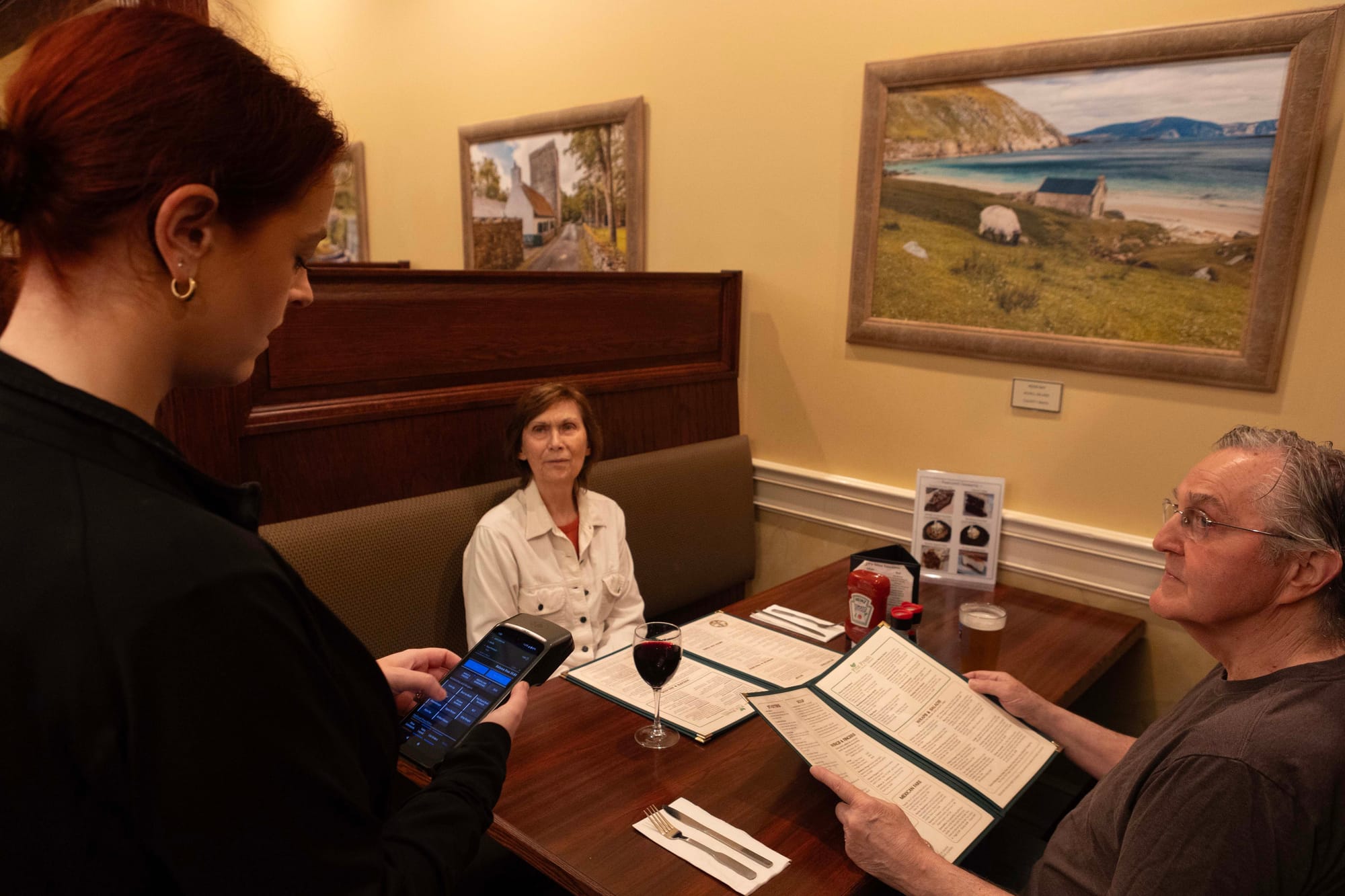
The main course is often the highlight of the dining experience, which makes clear communication and accuracy critical.
Servers can make the most of this moment by pointing out featured entrées or suggesting pairings.
In a fine dining restaurant, this might mean recommending wine pairings, while in an upscale casual concept, it could be calling out a favorite entree-and-side combination. Either way, thoughtful suggestions help increase sales while showing diners you're paying attention to the details.
Technology makes this part of service smoother, too. Handhelds send orders directly to kitchen staff, cutting down on errors and saving valuable time, while modifiers let servers note special requests or flag dietary restrictions, ensuring customers feel confident their needs are understood.
With timing tools like “fire” and “hold,” servers can pace the meal so entrées arrive at just the right moment.
Combined, these practices help staff deliver exceptional service that keeps all the guests at the table satisfied and engaged.
Step seven: Taking alcohol orders

Alcoholic beverages are, of course, taken during step four, but suggesting wine or cocktail drinks alongside the main course helps ensure proper pairing and keeps the flow of the meal seamless.
In fine dining establishments, this is where servers can demonstrate expertise by guiding guests through the wine list or recommending the right cocktail to complement entrées.
Technology supports this step by prompting servers with upsell options, such as profitable wines by the glass or reminders to suggest a full wine bottle for the table.
Whether it’s pouring a wine glass tableside or delivering cocktails quickly, attention to detail turns a simple order into part of creating memorable dining experiences. Done right, alcohol service blends hospitality with revenue opportunities while ensuring customers feel cared for.
Step eight: Running food
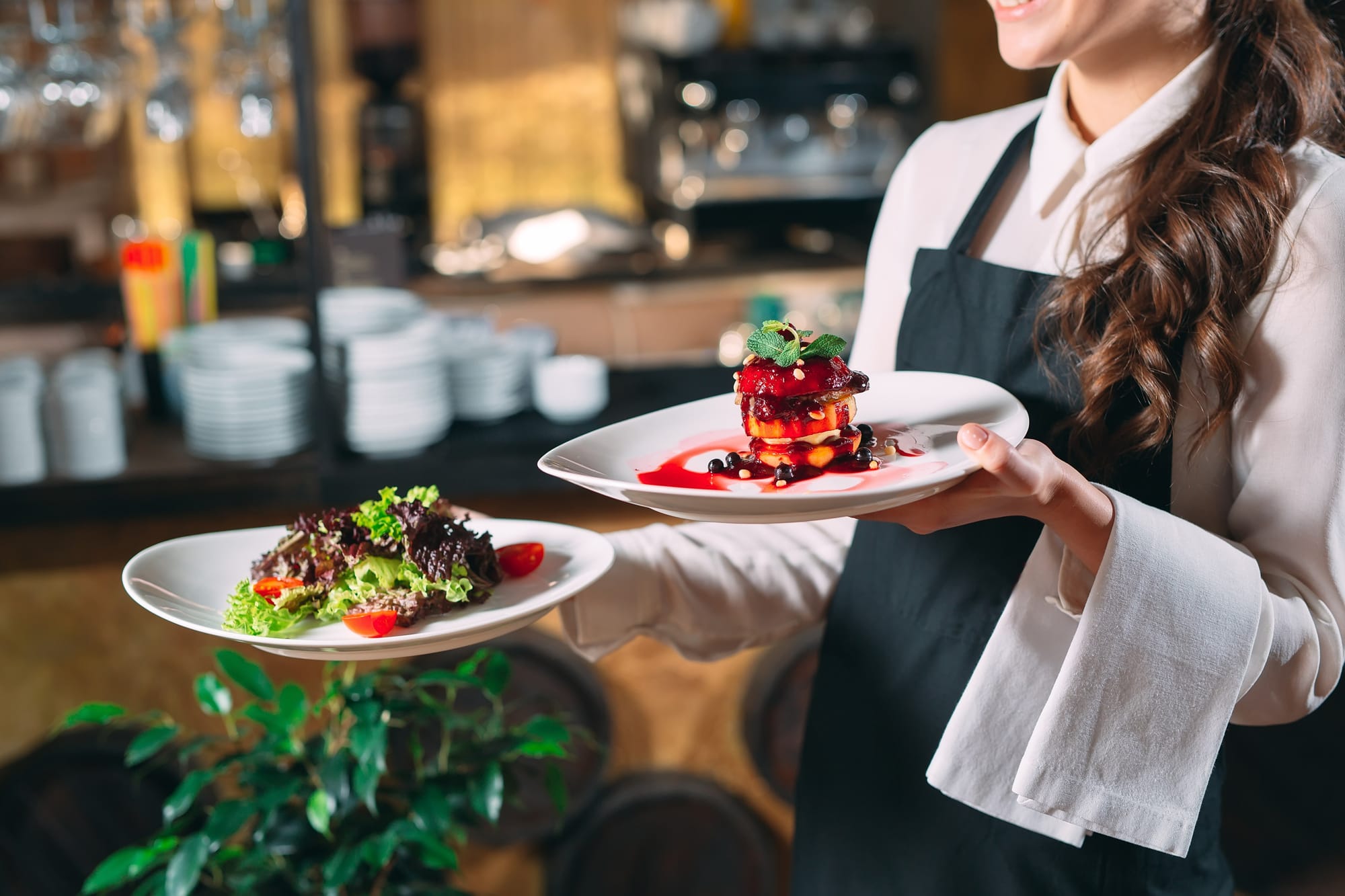
Running food happens throughout each of the steps of service, but there is a proper way to handle it. Depending on the concept, food is either run the moment it’s ready or waiting until the entire ticket is complete.
Technology makes this coordination much easier. KDS and expo screens show ticket status in real time, helping staff prioritize which plates should go out first.
Once it’s time to run food, ensure you’re taking the right dish to the correct table and that the plating is clean and presentable.
Before setting anything down, runners should double-check special requests like allergies, modifications, or dietary restrictions. That extra step prevents errors and reassures customers that their needs were taken seriously.
When done correctly, running food isn’t just about speed—it’s part of delivering exceptional customer service and ensuring all the guests enjoy a seamless flow from kitchen to table.
Step nine: Two-bite check and quality control
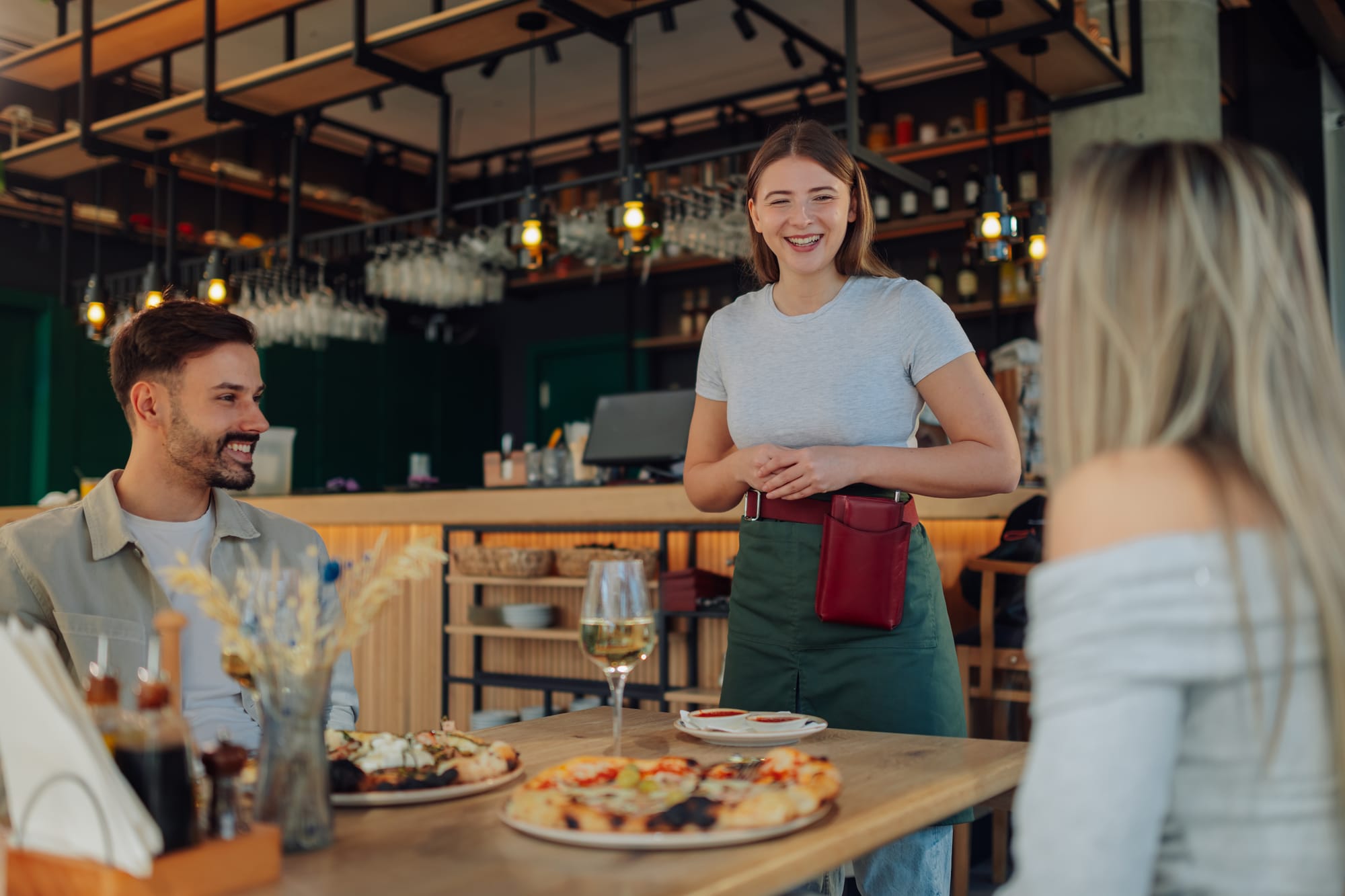
The two-bite check is one of the most important touchpoints in the steps of service. Even though it’s listed as step nine, it should happen anytime food or drinks are delivered.
Coming back to the table within two minutes, or after two bites, allows servers to handle any complaints or quality control issues that might arise during the beginning of the meal.
The two-bite check is also one of the best opportunities to boost sales.
Because handheld ordering speeds up drink delivery, guests are often ready for another round just as their food arrives. Servers can offer to refill drinks, suggest a new option, or point out a pairing that complements the order, turning a routine check-in into an easy upsell that feels natural.
And if something does need adjusting, handhelds make it possible to fix issues instantly—whether that means sending a replacement order, comping an item, or looping in a manager who can make any necessary adjustments from the server’s handheld.
Over time, these small, proactive touches lead to higher customer satisfaction and encourage repeat business, making the two-bite check a cornerstone of strong hospitality.
Step ten: Pre-bussing and table maintenance
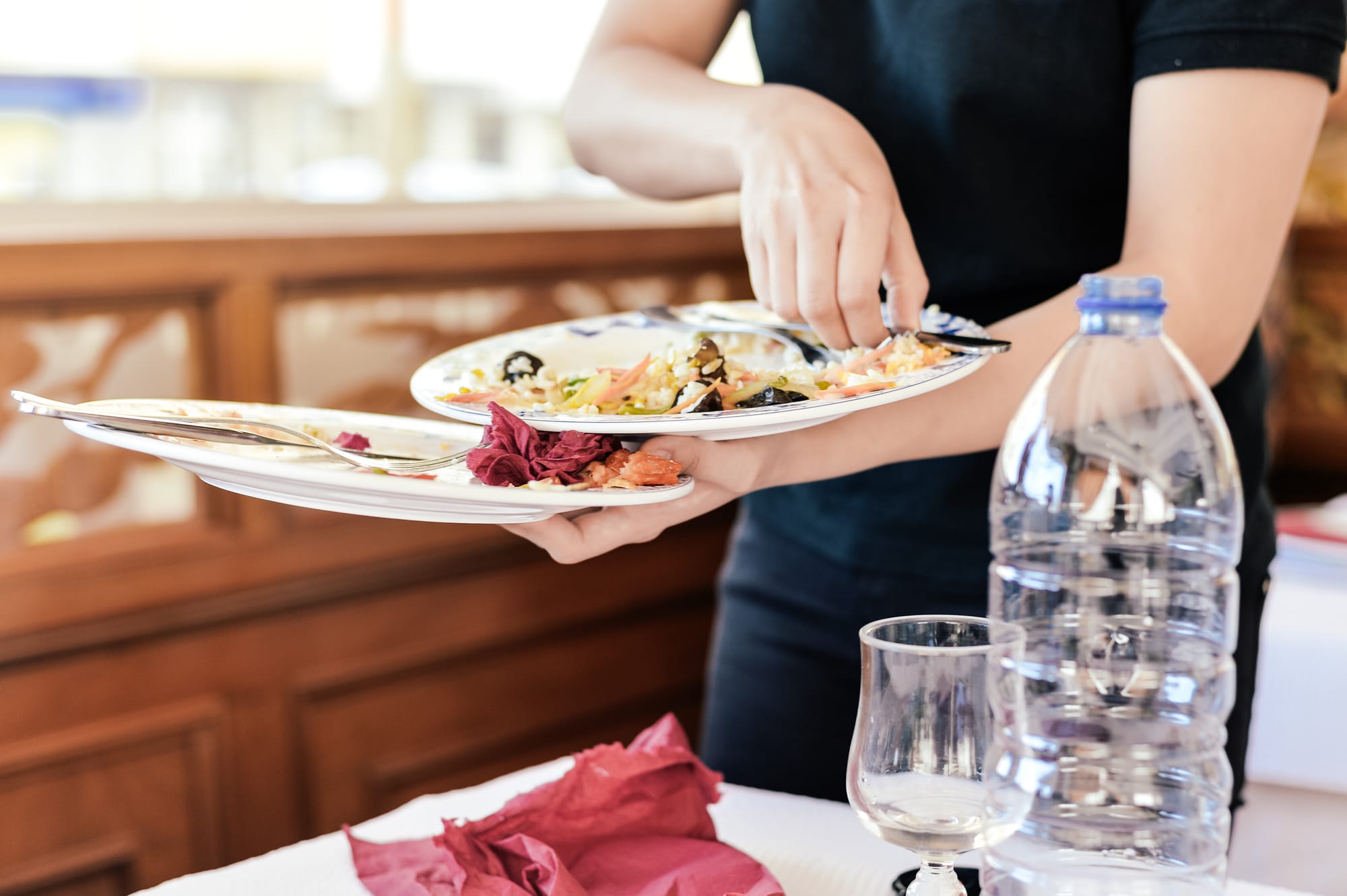
Like steps eight and nine, pre-bussing is something staff should be aware of and practice at all times.
Clearing plates, glassware, and clutter from the table keeps the space comfortable for customers and makes service feel polished. It also helps servers stay organized and ensures the table can be reset quickly for the next party once payment is complete.
This step also creates opportunities for connection. When a staff member removes an item, it’s the perfect moment to ask if guests would like a refill or anything else to complement their meal.
These touchpoints may feel simple, but they reinforce service standards and show attentiveness throughout the course of the evening.
Handled with care, pre-bussing isn’t just about clearing space; it’s about maintaining a smooth flow, keeping customers happy, and supporting a more enjoyable overall dining experience from start to finish.
Step eleven: Offering dessert and after-dinner drinks
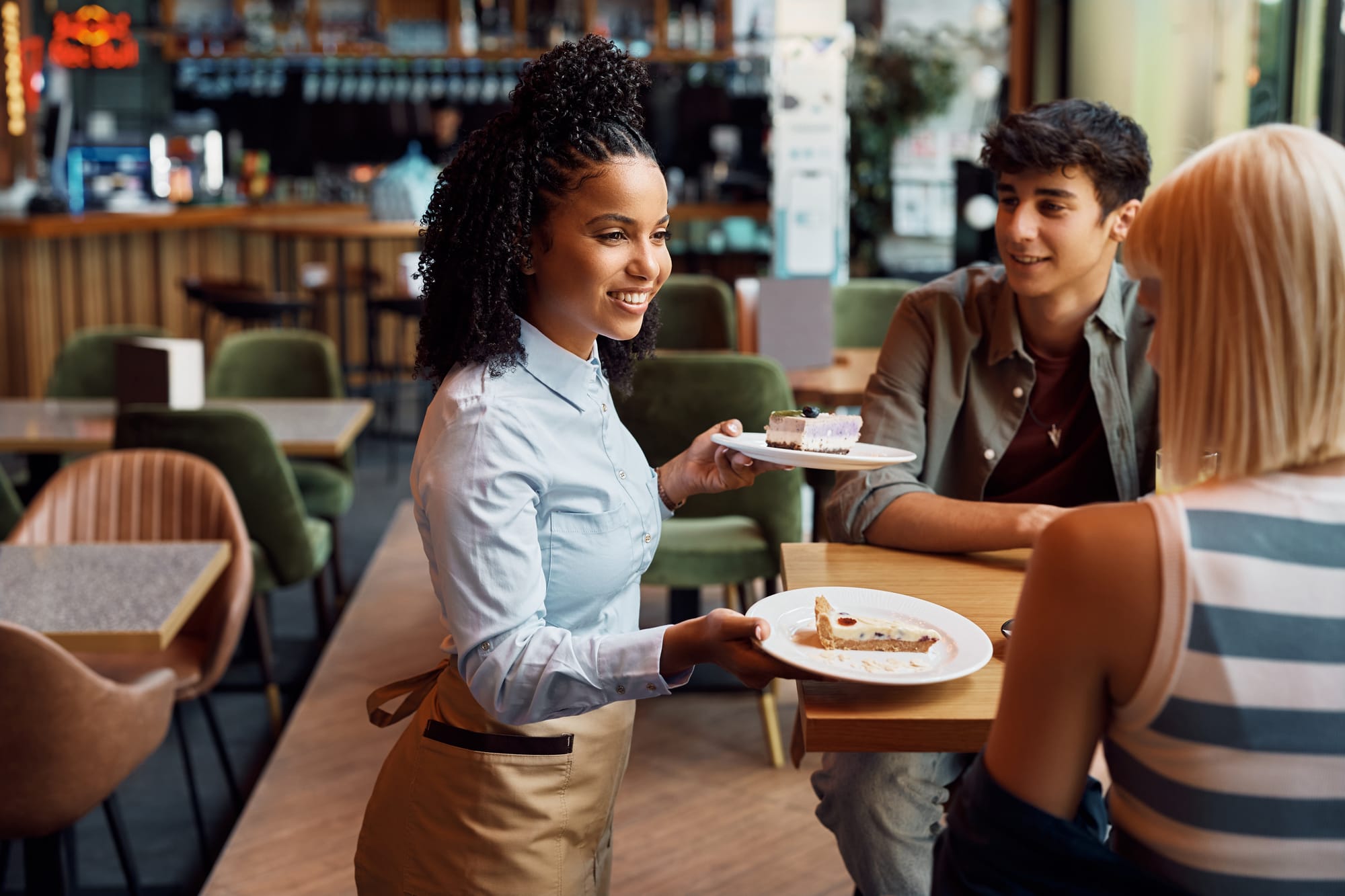
Dessert and after-dinner drinks give servers one last chance to elevate the dining experience. Timing is key—the offer should come only after entrées have been cleared, so it feels like a natural progression instead of a rushed upsell.
Handheld devices make this easier by showing detailed descriptions of dessert menu items, highlighting profitable upsells like dessert cocktails or coffee pairings, and even displaying images to spark curiosity.
Paying attention to notes about birthdays or anniversaries can also turn this moment into something special—like surprising a guest with a comped dessert that leaves a lasting impression.
Handled consistently across the team, these small gestures keep service smooth and ensure no opportunities are missed. Even a simple, well-placed question—“Would anyone like to finish with something sweet?”—can boost check averages while ending the experience on a high note.
Step twelve: Presenting the check and processing payment
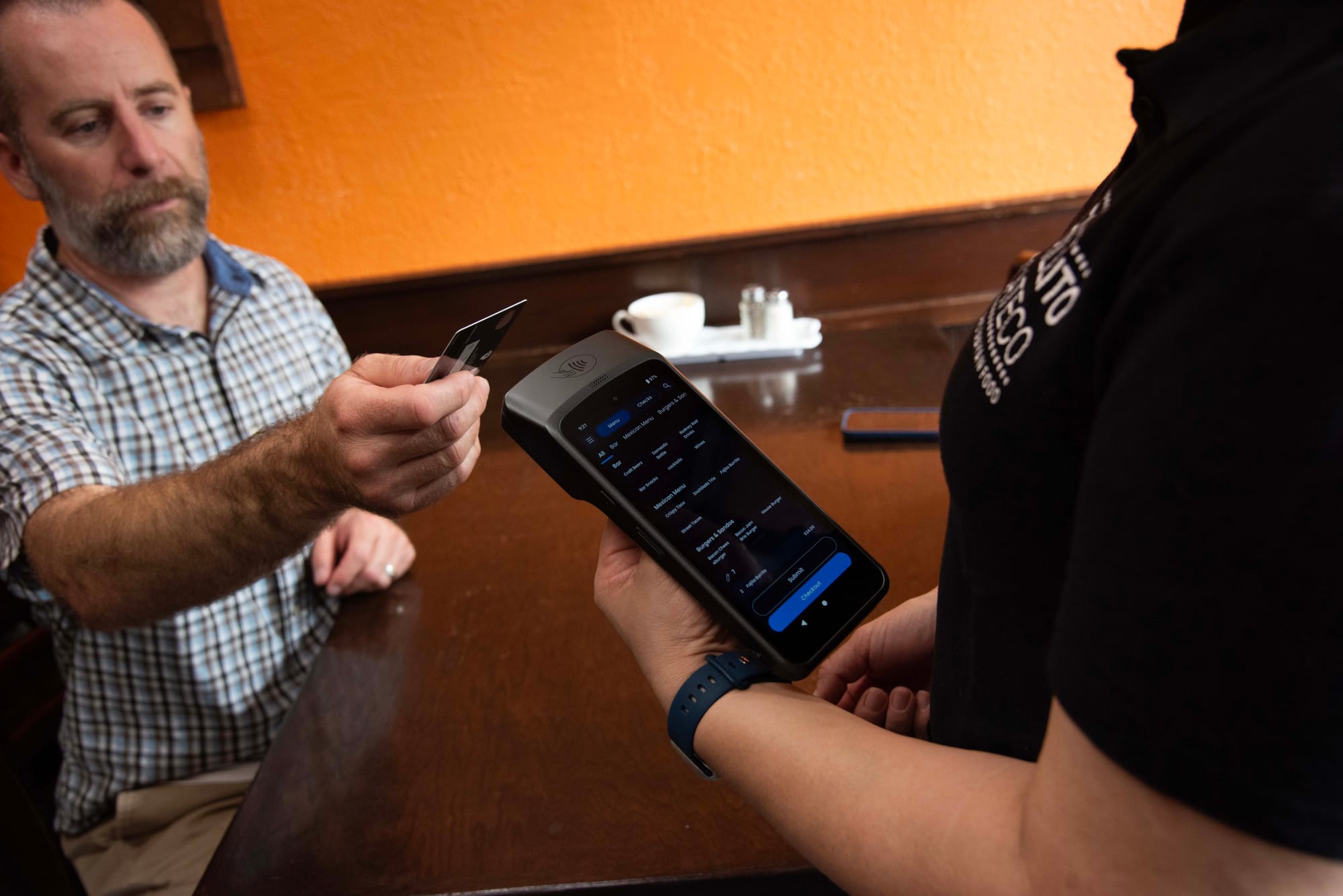
Before presenting the final check, ask if diners would like anything else before they leave, such as coffee, soft drinks, or even a dessert packaged to go to enjoy at home. This ensures they leave without feeling like they missed out on something they wanted.
Paying should be easy and flexible, whenever the customers are ready—not a step that slows things down.
Handheld devices make checkout smooth by letting guests pay and tip directly at the table. This prevents cards from getting misplaced on the way to and from the POS and eliminates unnecessary back-and-forth.
For those who prefer a self-pay option, scanning a QR code on the receipt offers another secure way to complete payment. Every system should provide these conveniences as part of modern service standards.
By giving diners control and minimizing friction, servers ensure payment feels like a seamless part of the meal. Combine that with the option to split checks easily or opt into loyalty programs, and you not only keep customers happy in the moment but also lay the groundwork for future repeat business and long-term success.
Step thirteen: Thanking and turning the table
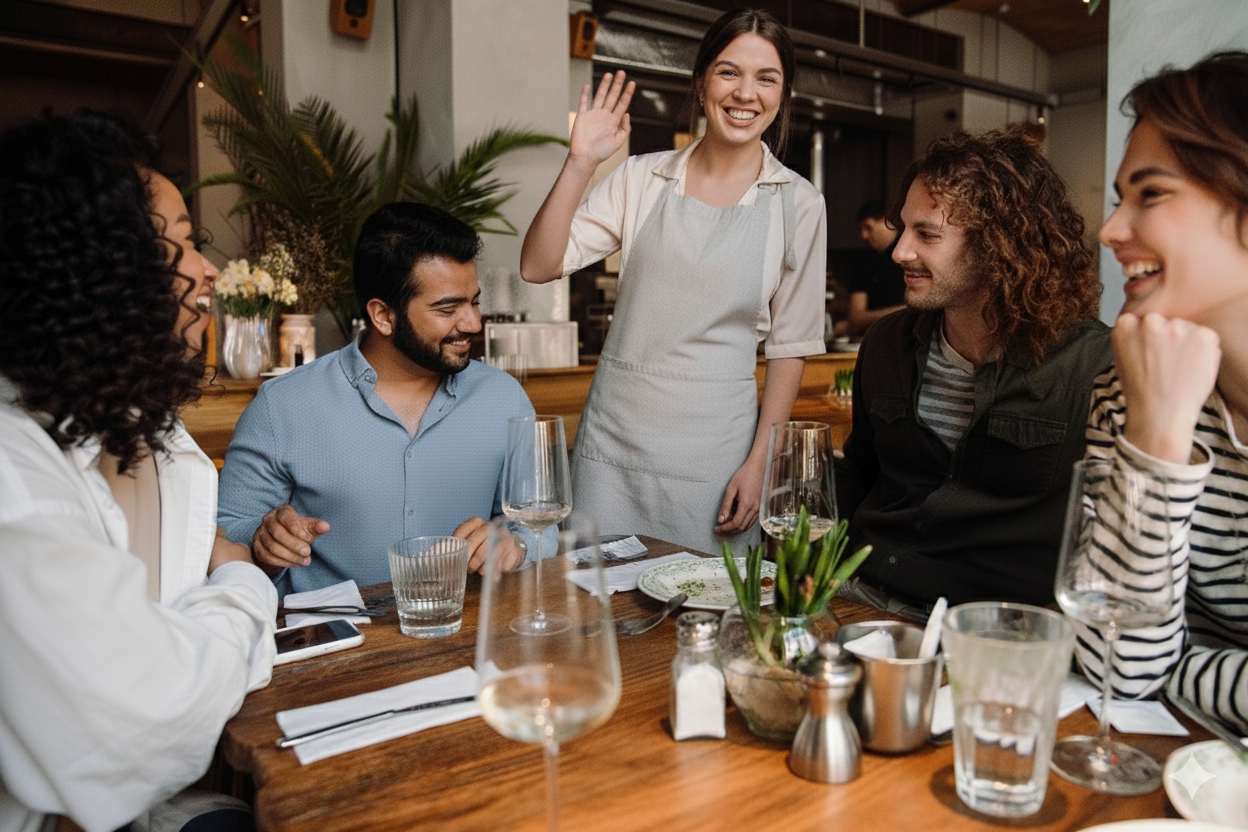
When diners are leaving, a genuine thank you shows appreciation and that it was an honor to serve food, serve drinks, and deliver exceptional service. Ending on a positive note locks in your restaurant’s reputation as an ideal location for special events or just a great time out.
Once customers have departed, efficiency matters.
The table should be reset and sanitized right away so it’s ready for the next party. Once cleared, servers mark the table as available in the POS, which updates the reservation system in real time. This fast rotation keeps the floor moving smoothly and allows for more turns on busy nights, while new guests walking in see a clean, inviting space.
Technology can extend the farewell beyond the restaurant.
Automated thank-you emails or SMS prompts for reviews encourage repeat business and give operators valuable feedback. Paired with excellent in-person hospitality, these follow-ups turn a simple goodbye into another step toward exceptional dining experiences.
Choosing the right technology for your restaurant
The heart of service will always be your team, but the right tools make it easier for them to be consistent, accurate, and efficient.
When you’re researching how to build your restaurant’s tech stack, focus on finding solutions that fit the way your restaurant already runs, rather than forcing a new system onto a process that’s working.
When evaluating solutions, look for platforms that are easy to use, backed by reliable support, and fully integrated across systems.
Reservation tools should communicate with the POS, handhelds should sync seamlessly with the kitchen, and reporting should be clear enough for managers to spot trends and ensure continuous improvement.
This kind of integration keeps staff members aligned and helps operators maintain high service quality even during peak times.
Compatibility also matters for long-term success. A POS that plays nicely with other tools makes upgrades smoother and prevents costly disruptions down the road. Think of it as investing not just in smoother service today, but in a foundation that will grow with your restaurant tomorrow.
At the end of the day, technology should take work off your staff’s shoulders, not add more. The better the tools fit your operation, the more time your team has to focus on guests, service, and the details that make each visit memorable.
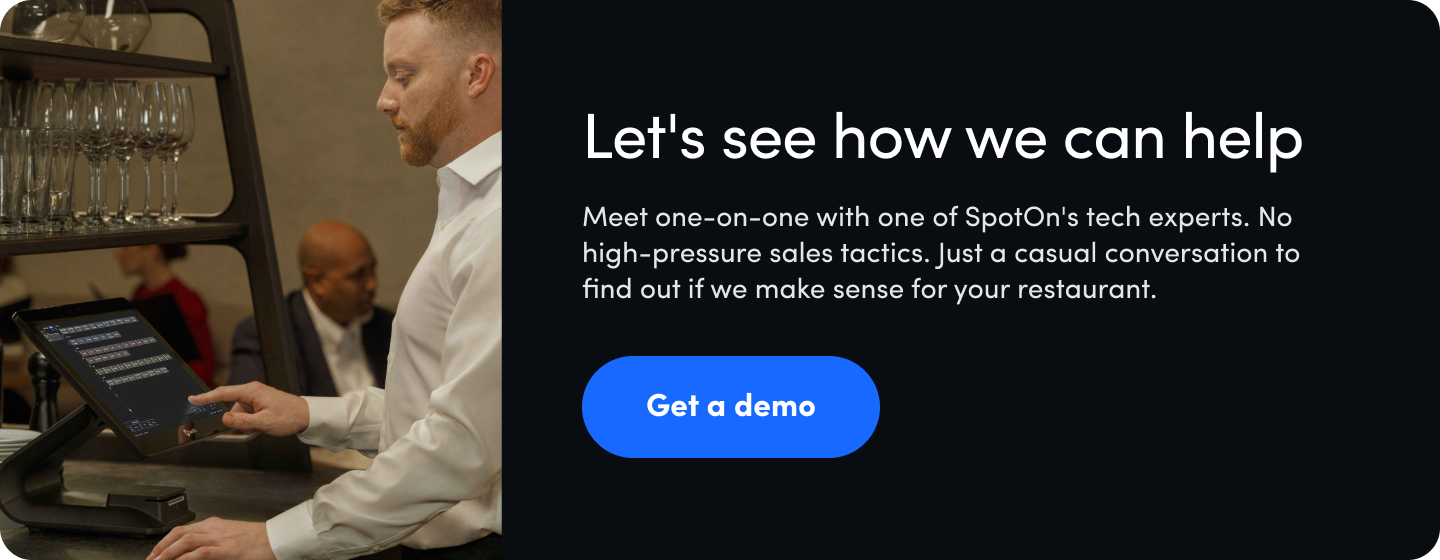
Frequently asked questions: Steps of service
Looking for quick answers to questions about the steps of service? Here are a handful of the most frequently asked questions.
What are the seven steps of service in restaurants?
Traditionally, the seven steps include greeting the guest, taking a drink order, taking a food order, delivering food and beverages, checking back, offering dessert or coffee, and presenting the check with a thank-you. Many operators expand this into a longer sequence, sometimes ten or more steps, to fine-tune the dining experience and improve their hospitality. The exact number may vary, but the goal is always consistency.
Why are the steps of service important for the guest experience?
The steps of service create a structure for the dining experience. Each step is a natural progression from the one before it, so guests feel like their wants and needs are being met without having to voice them. Drinks arrive quickly, food is served at the right pace, and servers check back just as questions or requests might come up.
This predictability builds comfort. Guests don’t have to flag someone down for refills, wonder when the check will arrive, or worry that their order was forgotten. Instead, they can relax and enjoy their meal, knowing the flow of service is designed to anticipate their needs. That reliability not only makes dining more enjoyable in the moment, but it also encourages them to return—because they trust they’ll receive the same level of care every time.
How does technology support greeting and seating guests?
Reservation and waitlist systems allow hosts to anticipate arrivals and seat parties in a way that balances the floor. SMS updates keep guests informed about their wait time, which helps reduce frustration. Notes saved in the system—like birthdays or seating preferences—also give staff the chance to personalize the welcome.
How does technology help with order accuracy and speed?
Handheld devices let servers enter orders tableside and send them directly to the kitchen or bar. This reduces delays, eliminates forgotten details, and helps orders come out faster. Modifiers also make it easy to adjust for allergies or substitutions, while prompts on the device encourage staff to suggest profitable add-ons.
How can servers use technology to provide more attentive service?
By removing back-and-forth trips to a stationary POS, handhelds give servers more time to spend with guests. They can process payments at the table, comp or resend items instantly, and check in more often. Beyond the meal, loyalty tools and automated follow-ups extend service even after guests leave, encouraging them to return.










